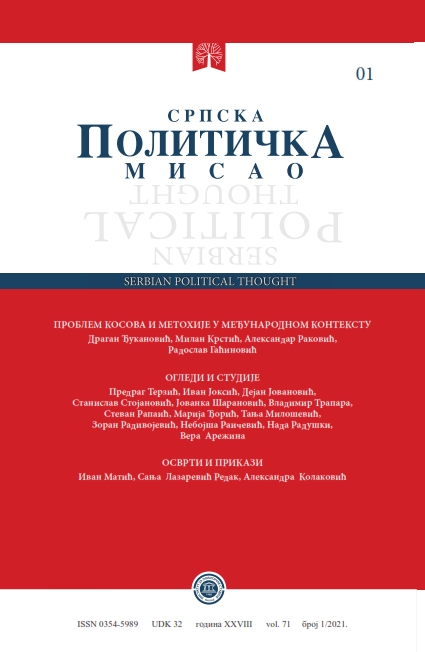ПРИВРЕДЕ ЗЕМАЉА ЗАПАДНОГ БАЛКАНА ‒ МЕСТО И УЛОГА СРБИЈЕ
ECONOMIES OF THE WESTERN BALKAN COUNTRIES ‒ THE PLACE AND ROLE OF SERBIA
Author(s): Stevan RapaićSubject(s): Politics / Political Sciences, Economy
Published by: Институт за политичке студије
Keywords: Cefta 2006;foreign trade;Serbia;Western Balkans
Summary/Abstract: The paper analyzes the state and structure of the economies of the Western Balkans, their characteristics, as well as their mutual influence, which is primarily expressed through the foreign trade within the CEFTA 2006 agreement. The author gives a comparative analysis of the state of the economies of the Western Balkans and explains the dominant role of Serbia in this region. Despite the fact that all observed countries trade the most with EU countries, Serbia stands out as their second most important foreign trade partner. The author reveals the place and role of Serbia in the economy of the Western Balkans, proving its leading position in regional trade. As the largest economy in the region and the largest market in the Western Balkans, Serbia is the dominant trader under the 2006 CEFTA agreement, and also stands out as the most successful in attracting foreign direct investment. The author explains the basic shortcomings of the Serbian economy but also answers the question of why, despite the inflow of foreign direct investments of over 22 billion euros, only in the previous ten years, Serbia has failed to achieve significant economic growth. Albania, Bosnia and Herzegovina, Montenegro, North Macedonia, and Serbia are countries with different levels of economic development, industrialization, and performance. Based on the presented macroeconomic indicators of the five observed countries and their most important trading partners, we were able to identify certain common factors. During the world economic crisis, all observed countries recorded a drastic decline in industrial production, ie a halt in economic growth. The process of privatization and deindustrialization is a common point in the countries of the Western Balkans, which in the observed period liberalized their foreign trade policy and promoted the inflow of foreign direct investment. All the economies of the Western Balkans suffer from a lack of domestic investment, high unemployment rates, have a large foreign trade deficit, public debt, are dependent on imports, and their exports are mainly based on low value-added products. The real economic growth of most of the observed countries in the last six years (before the outbreak of the Covid-19 crisis) was at an extremely low level and rarely exceeded 3%. In the period 2014-2019, Albania had an average growth of 2.9%, Bosnia and Herzegovina of 2.7%, Northern Macedonia of 2.8%, Serbia of 2.8%, and only Montenegro stands out with real GDP growth of 3.6%. With this state of the economy, virtually non-existent industry, and average salaries ranging from 390 euros in Albania to 525 euros in Montenegro, all Western Balkan economies are lagging behind the European Union average. For example, the average salary in Bulgaria in 2020, as the poorest EU member, was 690 euros, while in the same year in Serbia, as a leader in the Western Balkans, it reached only 512 euros. If we look exclusively at the trade relations of the Western Balkan countries, we can clearly conclude that Serbia is a leader in the region. Serbia is nominally the second most important foreign trade partner for all observed countries. When it comes to the 2006 CEFTA agreement, within which all trade in the Western Balkans takes place, Serbia is a leader with a foreign trade surplus in relation to all countries in the region. Serbia places about a quarter of its exports on the markets of CEFTA 2006, which is why the successful functioning of this agreement is of great importance for Serbia. However, although Serbia is by far the largest exporter in the region, its per capita exports are one of the lowest in Europe. The size of the Serbian economy, total GDP, the inflow of foreign direct investments, as well as the value of Serbian exports in relation to other countries in the region do not reflect the true picture. Serbia has a significantly higher population, so Montenegro still has a much higher GDP per capita, as well as an average salary, while Macedonia has a higher value of exports per capita. With the outbreak of the Covid-19 crisis, it is to be expected that in 2021, there will be a significant decline in the volume of foreign trade in intraregional trade, but the structure of exports and imports, ie Serbia’s position as a trade leader will not change. It could even be said that among other countries in the Western Balkans, there is a certain fear that Serbia, as the most important economy in the region, would be the dominant economic and political factor in the Western Balkans. However, by looking at the basic macroeconomic indicators, it is clear that Serbia has structural problems, which prevent it from being a hegemon of any kind in the region in the near future.
Journal: Српска политичка мисао
- Issue Year: 2021
- Issue No: 1
- Page Range: 169-199
- Page Count: 31
- Language: Serbian

